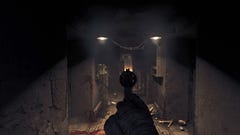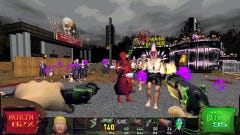Philips Evnia 42M2N8900 review: a colourful colossus of an OLED gaming monitor
This bold behemoth highlights the benefits – and costs – of OLED gaming screens
Gaming monitor makers are slowly getting on board with OLED as a viable panel type, something I’ve been perfectly happy about – even when the monitors themselves initially look, let’s be honest, a bit much. That’s likely going to be a common reaction to the Philips Evnia 42M2N8900, the OLED-powered headliner of Philips’ all-new gaming monitor range.
At 41.5in diagonally, it dominates space like a Saudi architecture proposal, and makes its 4K resolution a necessity as much as a luxury. Still, its unbeatable contrast, popping colours and excellent motion handling are good signs for OLED’s future in gaming hardware, provided you can live with its anti-burn-in measures.
Anyone with an OLED TV should already be well acquainted with its strengths: gorgeous colours, a thin panel profile that allows for slimmer designs, and essentially infinite contrast ratios. The latter two are owed to OLED’s system of self-illuminating pixels, bypassing the need for bulky backlighting and enabling each pixel to switch itself off to deliver a perfect shade of black. IPS and VA displays, which mostly employ edge-lit backlighting, don’t have that flexibility.
The Evnia 42M2N8900 takes this approach and slashes response time down as low as 0.1ms GTG, faster even than LG’s excellent Fast IPS panels. Add in a not-quite-144Hz-but-close-enough refresh rate, and this is an OLED monitor with real gaming chops. The result is that, as long as you have a graphics card and CPU capable of 4K, the Evnia 42M2N8900 plays as well as it looks – and it looks really bloody good.
Colours are vivid and diverse, especially if you leave the sRGB setting off to trade accuracy for extra vibrancy. Motion handling, something that my Philips OLED telly struggles with, is excellent, with zero ghosting or inverse ghosting on fast-moving objects. And the ability to display the deepest of deep blacks helps maintain details in dark scenes.
This performance is backed up by cold, hard numbers. In the Standard display mode, which is enabled by default, my colourimeter measured sRGB gamut coverage at a full 100% - as well as 95.4% for the DCI P3 gamut, which covers an even wider colour space. The higher the coverage, the better the onscreen colours, and while those colours aren’t reproduced accurately enough for jobs like photo editing (average delta-E is a middling 2.52), I’d happily lose that in favour of more intense-looking games. As to be expected from OLED, the black level dropped to 0cd/m², in turn leading to a contrast ratio of infinity:1.
Flipping on sRGB mode will get you a more neutral look, with higher colour accuracy: average delta-E fell to a more prim and proper 1.5 after I made the switch. Though perversely, it also meant sRGB gamut coverage dropped to 88.9%, with only black level and contrast remaining unchanged. This is one of those season-to-taste aspects of monitor settings, but again, on a gaming monitor specifically I prefer pop to accuracy. The Evnia 42M2N8900, happily, has plenty of the former.
It does have a weakness though, and maybe not one you’d expect from something with literally infinite contrast: low brightness. On a maxed out setting and in SDR (standard dynamic range) mode, I recorded this peaking at a workable yet unremarkable 200.5 cd/m². With HDR (high dynamic range) enabled, this climbed up to 362cd/m² - specifically, when holding the sensor over Final Fantasy XV’s sun – but that’s 28 nits short of even the lowest accepted standard for HDR content.
Brighter OLED panels exist, but between this mild brightness and some of the Evnia 42M2N8900’s other quirks, I get the sense that Philips are just very, very eager to avoid burn-in. This, if you’re unfamiliar, is when OLED screens retain a ghostly afterimage of whatever was left, unmoving, on screen for too long. Like the mark of a hot iron left on a forgotten shirt.
Along with the risk of static electricity in PC building, the likelihood of burn-in occurring is sometimes overexaggerated. You’re not going to melt an ammo counter into your OLED monitor if you play Warzone for a few hours. But it’s not some made-up boogeyman either, and keeping brightness high probably will increase the risk. Hence, the Evnia 42M2N8900’s so-so luminance.
I don’t actually think 200.5cd/m² is all that bad for games, especially when you’ve got great colour performance and a rock-bottom black level to help contrast. What could get tiring, though, is how high-maintenance this monitor can feel about avoiding burn-in at all costs. Take its auto-dimming, which kicks in whenever it thinks you’ve left it alone for a few minutes. This would be fine, and is so in games, except typing and moving the mouse cursor aren’t enough to keep it awake. Several times, simply over the course of writing this review, I’ve had to grab a window and wiggle it around to convince the Evnia 42M2N8900 I’m still using it. You can turn dimming off in the OSD, which I eventually did, though I’d rather not have to choose between regular loss of readability and a heightened chance of burning the pixels.
Like OLED TVs, the Evnia 42M2N8900 also needs regular refreshes to prevent its diodes from getting too friendly with a specific colour. Unlike OLED TVs, these are demanded every few hours, with an intrusive pop-up smack bang in the middle of the screen. Agreeing means the display is unusable for several minutes while the refreshing process does its thing. As with the dimming, I'm not questioning the value of this process in terms of combatting burn-in, but it is an inconvenience that other panel types don't impose.
Is the image quality worth this much housekeeping? Just about, in fairness, though the price is another cause for hesitation. If you just want to hop on the OLED train, there are much cheaper options even in the gigantic pseudo-TV category: Gigabyte’s Aorus FO48U is currently £818 on Amazon, and recently fell to £799. This is a bit of an outlier because most smaller, more manageable 27in OLED gaming monitors hang around the £1000 area, but that’s still much less of a kick in the wallet than the Evnia 42M2N8900. Which, by the way, is so vast that its pixel density works out to 106ppi, no higher than a 27in 1440p screen.
All that said, it was never going to be cheap. Colour and motion performance like this rarely is, and even away from the screen, the Evnia 42M2N8900 looks and feels compellingly plush. The all-white back panel is built from high-quality plastics and hides an impressive array of connections, including two HDMI 2.1 ports, should you wish to hook up a console as well. The weighty stand provides a solid base, and offers a surprisingly wide range of adjustment for such an enormous display.
You even get a version of Ambiglow lighting, my favourite feature on my Philips TV: its built-in ambient lighting that can dynamically match the shades of what’s visible onscreen. Looking down at a parched dustbowl, for example, will emit a sandy brown that automatically becomes blue as you raise the camera up to the sky. It’s not as bright and as stark as the lighting on my telly, unfortunately, and obviously it’s only visible if your desk (and thus the monitor) is up against a wall. But it’s nice to have.
As is the Evnia 42M2N8900 as a whole. Every time I narrow my eyes at another pixel refresh request, or indeed remember that it costs more than all my monthly housing and bill costs combined, it isn’t long before I’m staring in captured silence at just how pretty it makes games look. By all means, wait a bit until OLED gaming monitors are more plentiful and affordable, but to someone, somewhere out there who’s willing to pay for visual excellence, this screen already makes sense.
This review is based on a retail unit provided by Philips.




.jpg?width=240&height=135&fit=crop&quality=80&format=jpg&auto=webp)





